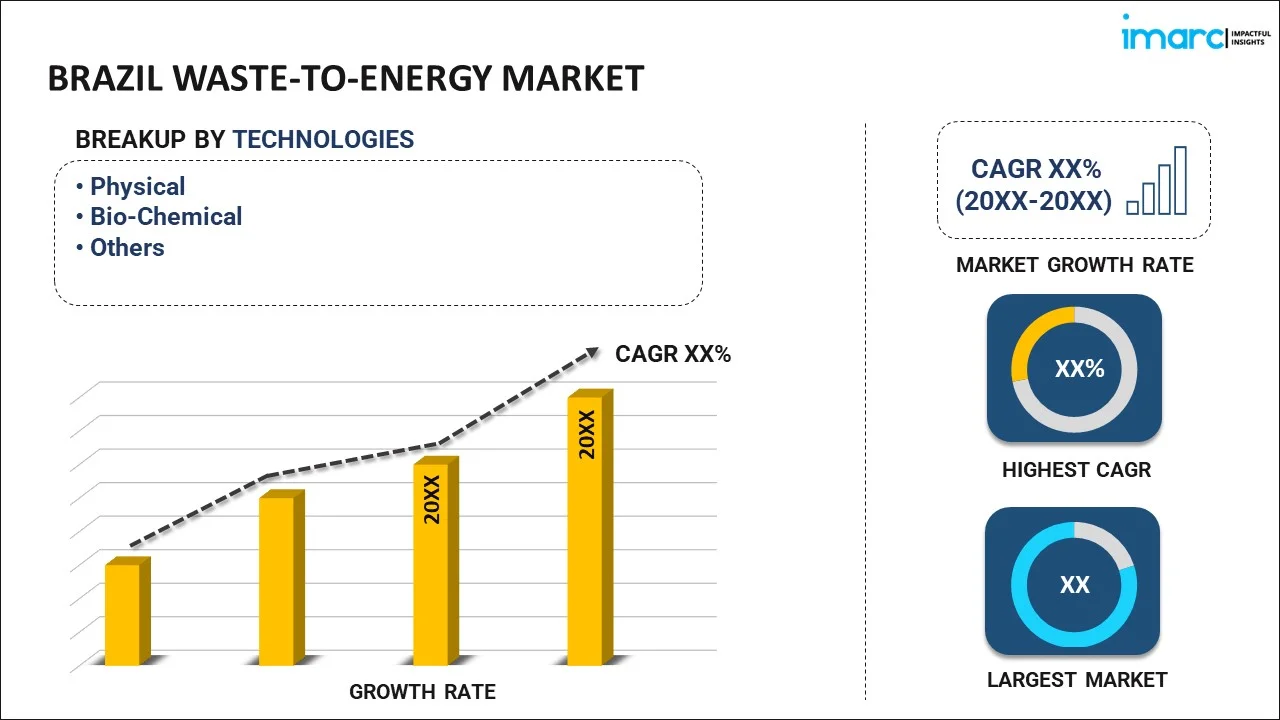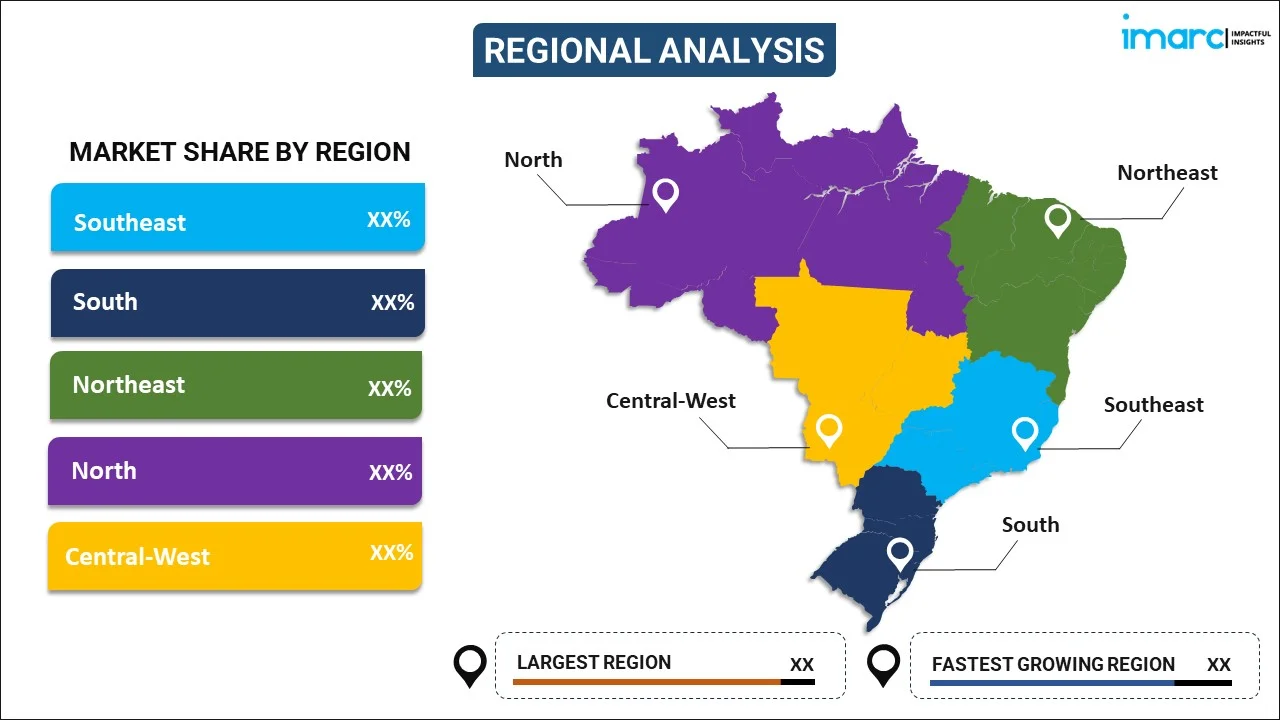
Brazil Waste-to-Energy Market Report by Technology (Physical, Bio-Chemical, and Others), and Region 2025-2033
Market Overview:
Brazil waste-to-energy market size reached USD 1,003.2 Million in 2024. Looking forward, IMARC Group expects the market to reach USD 1,440.3 Million by 2033, exhibiting a growth rate (CAGR) of 4.10% during 2025-2033. The escalating waste management needs due to the rising population and urbanization, stringent environmental goals, increasing government support, and heightened emphasis on sustainable waste management and clean energy generation represent some of the key factors driving the market.
|
Report Attribute
|
Key Statistics
|
|---|---|
|
Base Year
|
2024
|
|
Forecast Years
|
2025-2033
|
|
Historical Years
|
2019-2024
|
|
Market Size in 2024
|
USD 1,003.2 Million |
|
Market Forecast in 2033
|
USD 1,440.3 Million |
| Market Growth Rate 2025-2033 | 4.10% |
Waste-to-Energy (WtE) is a sustainable process that converts various types of waste materials, including municipal solid waste, agricultural residues, and industrial byproducts, into energy through thermal, biological, or chemical methods. It mainly focuses on the generation of electricity and heat from these waste sources. This is accomplished through combustion, anaerobic digestion, or other advanced technologies. The heat produced during these processes can be harnessed for district heating or industrial applications, while the electricity can be fed into the grid for broader consumption. This innovative approach reduces the waste volume in landfills and helps mitigate greenhouse gas emissions by providing an alternative to fossil fuels, aligning with global efforts to combat climate change and minimize dependence on non-renewable energy sources. As a result, waste-to-energy is gaining immense traction across Brazil as a vital component of sustainable waste management and renewable energy generation, offering an environmentally friendly solution to both waste disposal and energy needs.
Brazil Waste-to-Energy Market Trends:
The Brazil waste-to-energy market is experiencing substantial growth, driven by several key factors. Presently, Brazil is grappling with a mounting waste management challenge due to its growing population and urbanization. This has led to an increase in the generation of municipal solid waste, creating an urgent need for sustainable disposal solutions. WtE offers an attractive alternative to traditional landfilling, decreasing the burden on landfills and minimizing environmental impact, which is accelerating its adoption. Moreover, the rising need for energy diversification represents another major growth-inducing factor. Brazil has traditionally relied on hydropower for a significant portion of its electricity generation. However, the country is now looking to diversify its energy sources to reduce vulnerability to droughts and other climatic factors, making waste-to-energy an attractive option and thereby supporting market growth. Additionally, the country’s commitment to lowering greenhouse gas emissions and addressing climate change is further propelling the market growth as WtE facilities divert waste from landfills and produce renewable energy, helping Brazil meet its environmental goals and reduce its carbon footprint. In line with this, favorable government support and incentives have spurred investments in the WtE sector. Regulatory frameworks and policies, such as the National Solid Waste Policy and renewable energy incentives, have created a conducive environment for WtE projects, attracting both domestic and international investors looking to capitalize on the sector’s potential, thus fostering market growth. Furthermore, the heightened awareness among Brazilian consumers and businesses regarding the importance of sustainable waste management and clean energy generation has led to a growing demand for WtE solutions. This is particularly pronounced in industrial and urban areas, where waste generation is substantial, thus catalyzing market growth.
Brazil Waste-to-Energy Market Segmentation:
IMARC Group provides an analysis of the key trends in each segment of the market, along with forecasts at the country level for 2025-2033. Our report has categorized the market based on technology.
Technology Insights:

To get more information on this market, Request Sample
- Physical
- Bio-Chemical
- Others
The report has provided a detailed breakup and analysis of the market based on the technology. This includes physical, bio-chemical, and others.
Regional Insights:

- Southeast
- South
- Northeast
- North
- Central-West
The report has also provided a comprehensive analysis of all the major regional markets, which include Southeast, South, Northeast, North, and Central-West.
Competitive Landscape:
The market research report has also provided a comprehensive analysis of the competitive landscape in the market. Competitive analysis such as market structure, key player positioning, top winning strategies, competitive dashboard, and company evaluation quadrant has been covered in the report. Also, detailed profiles of all major companies have been provided.
Brazil Waste-to-Energy Market Report Coverage:
| Report Features | Details |
|---|---|
| Base Year of the Analysis | 2024 |
| Historical Period | 2019-2024 |
| Forecast Period | 2025-2033 |
| Units | Million USD |
| Scope of the Report | Exploration of Historical and Forecast Trends, Industry Catalysts and Challenges, Segment-Wise Historical and Predictive Market Assessment:
|
| Technologies Covered | Physical, Bio-Chemical, Others |
| Regions Covered | Southeast, South, Northeast, North, Central-West |
| Customization Scope | 10% Free Customization |
| Post-Sale Analyst Support | 10-12 Weeks |
| Delivery Format | PDF and Excel through Email (We can also provide the editable version of the report in PPT/Word format on special request) |
Key Questions Answered in This Report:
- How has the Brazil waste-to-energy market performed so far and how will it perform in the coming years?
- What is the breakup of the Brazil waste-to-energy market on the basis of technology?
- What are the various stages in the value chain of the Brazil waste-to-energy market?
- What are the key driving factors and challenges in the Brazil waste-to-energy?
- What is the structure of the Brazil waste-to-energy market and who are the key players?
- What is the degree of competition in the Brazil waste-to-energy market?
Key Benefits for Stakeholders:
- IMARC’s industry report offers a comprehensive quantitative analysis of various market segments, historical and current market trends, market forecasts, and dynamics of the Brazil waste-to-energy market from 2019-2033.
- The research report provides the latest information on the market drivers, challenges, and opportunities in the Brazil waste-to-energy market.
- Porter's five forces analysis assist stakeholders in assessing the impact of new entrants, competitive rivalry, supplier power, buyer power, and the threat of substitution. It helps stakeholders to analyze the level of competition within the Brazil waste-to-energy industry and its attractiveness.
- Competitive landscape allows stakeholders to understand their competitive environment and provides an insight into the current positions of key players in the market.
Need more help?
- Speak to our experienced analysts for insights on the current market scenarios.
- Include additional segments and countries to customize the report as per your requirement.
- Gain an unparalleled competitive advantage in your domain by understanding how to utilize the report and positively impacting your operations and revenue.
- For further assistance, please connect with our analysts.
 Request Customization
Request Customization
 Speak to an Analyst
Speak to an Analyst
 Request Brochure
Request Brochure
 Inquire Before Buying
Inquire Before Buying




.webp)




.webp)












